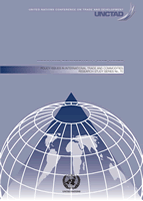
Access to foreign markets is a critical determinant of export performance. In technical literature foreign market access is seen as representing the foreign market potential of a country and relates inter alia inversely to bilateral transport costs.
The existence of a direct maritime connection has also been recognized to play an important role in determining trade costs. However, little theoretical and empirical attention has been devoted to its impact on bilateral exports. The lack of comprehensive evidence on the relationship between maritime connections and bilateral exports is due to the lack of data to a large extent.
The objective of this paper is to fill this gap by using novel information on maritime connections for a sample of 178 countries collected over the 2006-2012 period. Some basic statistical analysis reveals that over the whole period on average about 14 per cent of country pairs are connected directly, about 11 per cent need a single transhipment, about 36 per cent two transhipments and about 28 per cent three transhipments. This is to say that about 61 per cent of country pairs are connected with no more than two transhipments and around 90 per cent with no more than three transhipments.
This paper is a first assessment of the impact of the nature of maritime connections on bilateral exports of containerizable goods using a comprehensive set of country pairs observed over several years. Although a causal relationship remains difficult to identify, our estimates suggest that the absence of a direct connection is associated with a drop in exports value varying between 42 and 55 per cent depending on the underlying empirical specification. Results also indicate that any additional transhipment is associated with a drop in exports value varying between 20 and 25 per cent.
We also find evidence that the relationship between bilateral exports and the number of transhipments necessary to transport containerizable goods between two countries is likely to be non-linear. These results suggest that the quality of maritime connectivity is likely to be a preponderant determinant of foreign market access.
By definition landlocked could not enjoy any direct connection with any trade partner but contiguous countries. The above results provide an estimate of the handicap in terms of export value landlocked countries have to face on top of the impact of the quality of transit transports.
High transport costs continue to constitute the greatest impediment to LDCs’ trade competitiveness, equitable access to global markets. The improvement of the quality of maritime connectivity should be at the core of any strategy aiming at stimulating exports and promoting the participation of the domestic economy in global chains of production. Such improvement could only contribute to the reduction of transport costs.
Intervening efficiently on maritime connectivity is certainly not an easy task. Several options exist and their respective desirability could only reflect country specific characteristics. However, investing in infrastructures would be vital in all options. This would require a financial effort most countries are not able to bear alone. International cooperation and partnerships is thus crucial.
International cooperation and partnerships could take the form of establishing strategies aiming at creating incentives for shipping companies to serve destinations which are not necessarily profitable in first place. For instance, it could consist in granting companies serving "remote" countries some preferential access to major maritime hubs around the world.



